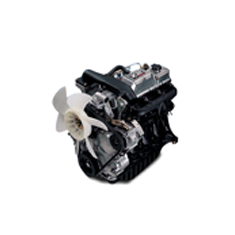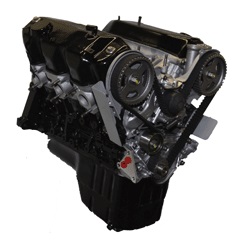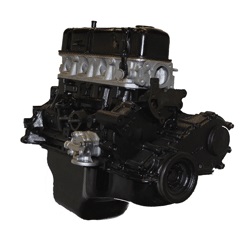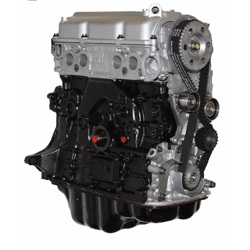
1-800-210-8170
MON-SAT 6AM-5PM PST,9AM-8PM EST24/7 ONLINE






We distribute an extensive selection of FORKLIFT ENGINE parts for all makes and models. We ship directly from various warehouses located all over North America to provide the fastest shipping at the most affordable prices.
The Forklift Engine is a machine designed to convert chemical energy into mechanical energy. By burning fuel through internal combustion in a series of pressurized cylinders, the engine creates motion that mobilizes a vehicle. The principle governing a reciprocating internal combustion engine is that if a sizeable amount of energy fuel is put in a small enclosed cylinder or container and is ignited, it can produce an incredible amount of energy in gaseous state which tends to expand beyond the boundaries of that vessel. That produced energy can be put to use to push forward objects in a thrust. If properly harnessed, that tremendous energy can work well to drive your forklift truck away.
Internal combustion engines follow a four-stroke combustion cycle, which was first invented by Nikolaus Otto in 1867. Following stages form part of four strokes: Internal stroke, Compression stroke, combustion stroke and exhaust stroke. The main parts of an engine are as follows: head cylinder, cylinder block, intake valves, exhaust valves, pistons, piston rings, connecting rods, sparkplugs crankshaft, gaskets, and seals.
When the internal combustion cycle starts, the piston begins at the top. The intake valves open up and the piston moves down, enabling the engine to take in a cylinder filled with air and gasoline. This is an intake stroke in forklift internal combustion engine, when only a small drop of gasoline mixes with air to make it work. In the next step, the piston moves back up and compresses the air and fuel mixture. Compression takes place, which makes the upcoming explosion more powerful. Upon reaching the top of its stroke, the piston finds the spark plug emitting a spark, which in turn ignites the compressed and highly pressurized gasoline mixture. Ignition causes the gasoline in the cylinder to explode and the explosion releases energy, which forcibly drives the piston down.
When piston moves down and hits the bottom, the exhaust valve opens and let the exhaust go out of the tailpipe. This is where the four strokes end completing a cycle and the engine gets ready for the next cycle, taking the next charge of air and gasoline mix. In the engine, the linear motion of piston is transformed to rotational motion by the crankshaft. The rotational motion is necessary to allow the engine power translated to the wheels and rotate them.
The core of the engine is cylinder, in which the piston moves vertically up and down. The internal combustion for the stroke cycle explained, exemplifies a single cylinder. However, in most of the forklift trucks more than one cylinder works, where commonly used are four, six and eight cylinders, enabling the forklift truck to perform heavy-duty jobs. Hence, when more than one cylinder is put to use, they need to be arranged in a configuration for optimum output.
The usual arrangements for more than one cylinder are made in three ways; the inline, V or flat arrangement. These configurations offer specific advantages and disadvantages, while considering the intrinsic outputs of smoothness, cost effect and shape characteristics. Choosing between these plus and minuses determine which arrangement is to be used in which sort of forklift truck.
The spark plug signifies the next important part responsible for the combustion in internal combustion engines of the forklift trucks. The spark plug provides the necessary spark that ignites the air and fuel mixture for combustion to take place. The timing of spark plug to initiate a spark is of even more importance. The spark should be initiated only at the right time with ultimate precision, failing will cause functioning troubles in the engine’s performance. The ideal would be to ignite a spark when the whole mixture of air and gasoline is at the bottom of cylinder, fully compressed. Ignition at this stage will produce maximum thermal energy resulting in a stronger drive force.
After having utilized the energy required to put the forklift truck in motion, the residual waste is to be exhausted. This is where valves come into play. Intake and exhaust valves open and shut at required times to first let in the air gas mixture and to let the exhaust out. Valves remained closed during compression and combustion effectively sealing the combustion chamber.
Due to the internal combustion, the engine can experience extremely high temperatures while operating. This increase in temperature, which is regulated through the cooling system, utilizes hydraulics to effectively cool down the engine. The cooling system is mainly composed of radiators, water pumps, belts, thermostat and a series of hoses. The engine is also supported by a series of electrical and mechanical parts such as alternators, carburetors, starters and solenoids.
Similar to most mechanical parts and components, the engine experiences wear and damage over time. Scheduled maintenance, regular tune ups, and routine oil change can prevent subsequent damages. The following points are six signs of common forklift engine problems:
The engine problems are mostly avoided when maintained on a regular basis. But, over extensive use and age, they can be unavoidable. Solid Lift Parts Inc. provides engine parts for all makes and models of forklifts. Contact your parts specialist today to find you affordable engine parts for your specific forklift model!
Forklift Engine Parts Photos



*Manuals and parts books are not owned by Solid Lift Parts inc. and are presented for reference purpose only.